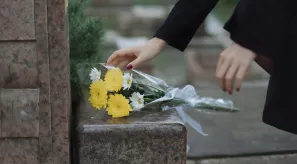Collecting the ashes after a cremation is a deeply emotional and symbolic moment for many families. It raises important questions — both practical and personal — especially for those facing this process for the first time: how are ashes collected from a cremation chamber?
At Stelae, a funeral company exclusively dedicated to cremation services, we assist hundreds of families every year with empathy and professionalism. This article explains, step by step, what happens after a cremation, how the ashes are collected, and what options are available — including what happens if ashes are not collected from the crematorium.
What happens immediately after the cremation?
Once the cremation is complete, our experienced cremation technicians follow a series of regulated procedures to ensure that the ashes are handled and delivered respectfully and safely.
Cooling of the remains
The cremation chamber reaches temperatures above 850°C. After the cremation ends, the remains—mainly bone fragments—must cool down before they can be handled. This process typically takes between 30 and 60 minutes and is done in a dedicated area under strict safety protocols.
Processing of the remains
Once cool, the fragments are carefully collected using special tools. Contrary to what many people think, the ashes are not powder — they consist of small, calcified bone pieces. These are placed in a device known as a cremulator, which processes the fragments into a fine, sand-like consistency.
Each set of remains is handled individually and tracked throughout the entire process using a secure labeling system, ensuring that the ashes returned belong 100% to the correct person.
Delivery of the ashes to the family in the urn
The processed ashes are placed into a cremation urn, either chosen in advance by the family or provided by the crematorium. In Stelae’s case, this handover is done in a calm, private space — and if the family wishes, with a funeral advisor present to guide them.
Whether it is a traditional cremation with ceremony or a direct cremation, the standards of safety, respect, and traceability remain exactly the same.
Options for the final disposition of the ashes
Once collected, the family has several legal and meaningful ways to preserve or release the ashes of a loved one.
Keeping the ashes at home
Many families choose to keep the urn at home, often placing it in a memorial space or family altar. This can provide comfort and a continued sense of closeness to the person who has passed.
Scattering the ashes in authorized locations
Ashes may also be scattered in the sea, nature, or memorial gardens. It is essential to do so only in permitted areas and, in some cases, obtain prior authorization. At Stelae, we offer guidance to ensure this is done legally and with the utmost care and respect.
What happens if ashes are not collected from the crematorium?
Although not common, there are times when the family cannot collect the ashes. Crematoria are prepared to handle these cases in a regulated and respectful manner.
Temporary storage at the crematorium
Crematoria generally store ashes for a set period, usually between 30 and 90 days, depending on local regulations. During this time, they will attempt to contact the family or the person responsible for the cremation service to arrange collection. If you anticipate a delay, it is important to notify the crematorium to avoid automatic actions.
Scattering in a memorial garden
If the ashes are still not collected after the legal timeframe, the crematorium may proceed to scatter them in a registered memorial garden. This is a dignified, documented process in accordance with funeral regulations, ensuring the ashes are not discarded or mishandled.
Frequently asked questions about collecting ashes
How long does it take to receive the ashes?
Ashes are typically ready within 24 to 72 hours after the cremation. In cases of direct cremation or urgent services, this timeframe can be reduced with proper coordination.
Can I collect the ashes if I’m not a direct family member?
Only the person who arranged the cremation or someone with written authorization may collect the ashes. This policy protects families and ensures the remains are handled with legal and emotional responsibility.
What happens if I don’t collect the ashes in time?
If the collection window expires, the crematorium will follow its official procedure: first storing the ashes temporarily, and eventually scattering them in a memorial garden. Communicating any delays in advance is the best way to avoid this outcome and ensure respectful handling.



